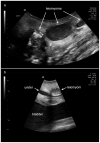Reproductive tract tumours: the scourge of woman reproduction ails Indian rhinoceroses
- PMID: 24671211
- PMCID: PMC3966795
- DOI: 10.1371/journal.pone.0092595
Reproductive tract tumours: the scourge of woman reproduction ails Indian rhinoceroses
Abstract
In Indian rhinoceros, extensive leiomyoma, a benign smooth muscle tumour, was sporadically diagnosed post mortem and commonly thought of as contributing factor for reduced fecundity of this species in captivity. However, to date, the prevalence of reproductive tract tumours and their relevance for fecundity are unknown. Our analysis of the international studbook now reveals that females cease reproducing at the age of 18.1±1.2 years; equivalent to a reproductive lifespan of just 9.5±1.3 years. This short reproductive life is in sharp contrast to their longevity in captivity of over 40 years. Here we show, after examining 42% of the captive female population, that age-related genital tract tumours are highly prevalent in this endangered species. Growth and development of these tumours was found to be age-related, starting from the age of 10 years. All females older than 12 years had developed genital tumours, just 7-9 years past maturity. Tumour sizes ranged from 1.5-10 cm. With age, tumours became more numerous, sometimes merging into one large diffuse tumour mass. These tumours, primarily vaginal and cervical, presumably cause widespread young-age infertility by the age of 18 years. In few cases, tumour necrosis suggested possible malignancy of tumours. Possible consequences of such genital tract tumour infestation are hindered intromission, pain during mating, hampered sperm passage, risk of ascending infection during pregnancy, dystocia, or chronic vaginal bleeding. In humans, leiomyoma affect up to 80% of pre-menopause women. While a leading cause for infertility, pregnancy is known to reduce the risk of tumour development. However, different from human, surgical intervention is not a viable treatment option in rhinoceroses. Thus, in analogy to humans, we suggest early onset and seamless consecutive pregnancies to help reduce prevalence of this disease, better maintain a self-sustained captive population and improve animal welfare.
Conflict of interest statement
Figures


Similar articles
-
Ovarian down Regulation by GnRF Vaccination Decreases Reproductive Tract Tumour Size in Female White and Greater One-Horned Rhinoceroses.PLoS One. 2016 Jul 12;11(7):e0157963. doi: 10.1371/journal.pone.0157963. eCollection 2016. PLoS One. 2016. PMID: 27403662 Free PMC article.
-
The effect of long non-reproductive periods on the genital health in captive female white rhinoceroses (Ceratotherium simum simum, C.s. cottoni).Theriogenology. 2006 May;65(8):1492-515. doi: 10.1016/j.theriogenology.2005.09.002. Epub 2005 Oct 5. Theriogenology. 2006. PMID: 16213012
-
Reproductive soundness of captive southern and northern white rhinoceroses (Ceratotherium simum simum, C.s. cottoni): evaluation of male genital tract morphology and semen quality before and after cryopreservation.Theriogenology. 2005 Jan 1;63(1):219-38. doi: 10.1016/j.theriogenology.2004.04.007. Theriogenology. 2005. PMID: 15589286
-
Reproductive problems directly attributable to long-term captivity--asymmetric reproductive aging.Anim Reprod Sci. 2004 Jul;82-83:49-60. doi: 10.1016/j.anireprosci.2004.05.015. Anim Reprod Sci. 2004. PMID: 15271443 Review.
-
Reproductive potential in the older woman.Fertil Steril. 1986 Dec;46(6):989-1001. doi: 10.1016/s0015-0282(16)49869-9. Fertil Steril. 1986. PMID: 3536609 Review.
Cited by
-
Case Report: Ovulation Induction in Greater One-Horned Rhinoceros (Rhinoceros unicornis).Front Vet Sci. 2021 Jun 30;8:657284. doi: 10.3389/fvets.2021.657284. eCollection 2021. Front Vet Sci. 2021. PMID: 34277752 Free PMC article.
-
Ethical Analysis of the Application of Assisted Reproduction Technologies in Biodiversity Conservation and the Case of White Rhinoceros (Ceratotherium simum) Ovum Pick-Up Procedures.Front Vet Sci. 2022 May 3;9:831675. doi: 10.3389/fvets.2022.831675. eCollection 2022. Front Vet Sci. 2022. PMID: 35591869 Free PMC article. Review.
-
Of Elephants and Other Mammals: A Comparative Review of Reproductive Tumors and Potential Impact on Conservation.Animals (Basel). 2022 Aug 8;12(15):2005. doi: 10.3390/ani12152005. Animals (Basel). 2022. PMID: 35953994 Free PMC article. Review.
-
What do women and rhinos have in common?F S Rep. 2025 Apr 15;6(Suppl 1):19-23. doi: 10.1016/j.xfre.2025.01.008. eCollection 2025 Apr. F S Rep. 2025. PMID: 40487317 Free PMC article.
-
Ovarian down Regulation by GnRF Vaccination Decreases Reproductive Tract Tumour Size in Female White and Greater One-Horned Rhinoceroses.PLoS One. 2016 Jul 12;11(7):e0157963. doi: 10.1371/journal.pone.0157963. eCollection 2016. PLoS One. 2016. PMID: 27403662 Free PMC article.
References
-
- IUCN (2013) African rhinos won't hold out for much longer, IUCN experts warn. Available: http://www.webcitation.org/6IrjBYZBh. Accessed 2013 Aug 14.
-
- WWF (2010) Javan rhino found dead in Vietnam. Available: http://www.webcitation.org/6IrjW0nCz. Accessed 2013 Aug 14.
-
- Foose TJ, van Strien NJ (1997) Asian rhinos: Status survey and conservation action plan. Gland, Switzerland: IUCN. i-v, 1–112 p.
-
- Dinerstein E (2003) The Return of the Unicorns: The Natural History and Conservation of the Greater One-Horned Rhinoceros. New York: Columbia University Press. 384 p.
-
- von Houwald F, Pagan O (2012) Greater One-Horned or Indian Rhinoceros Rhinoceros unicornis Linné 1758, International Studbook 2011. Basel, Switzerland: Basel Zoo. 63 p.
MeSH terms
LinkOut - more resources
Full Text Sources
Other Literature Sources
Miscellaneous

